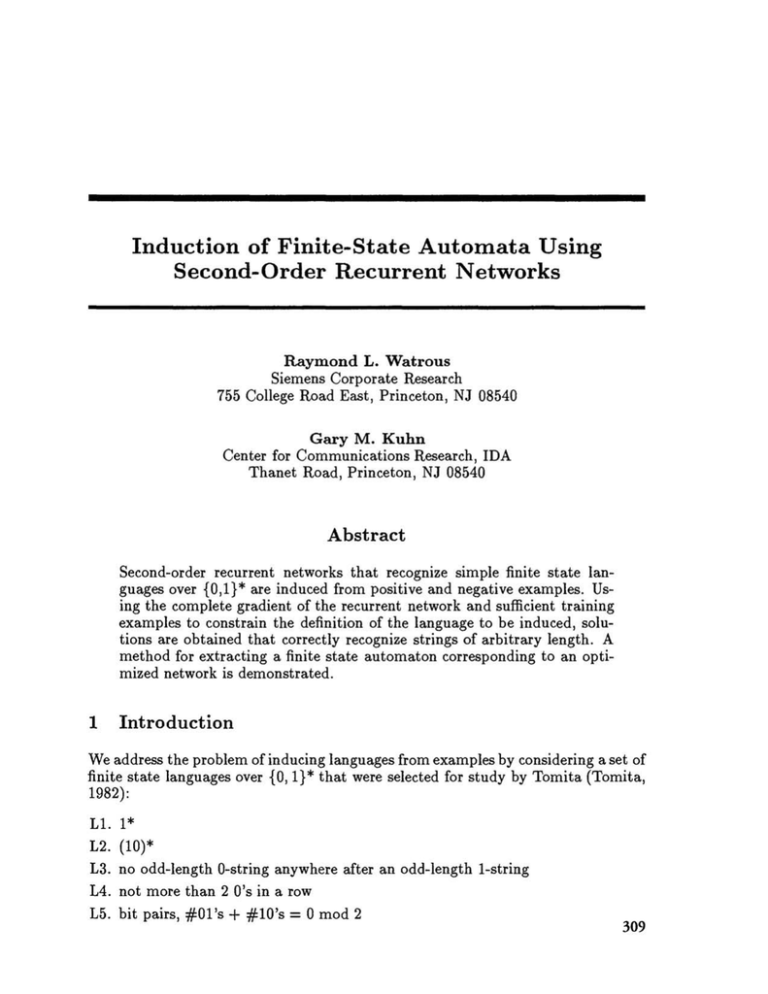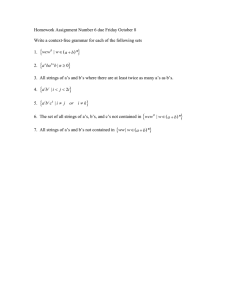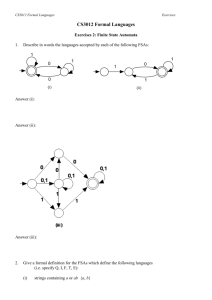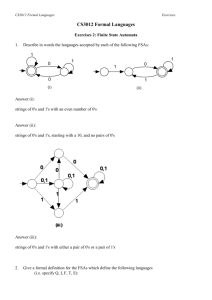Induction of Finite-State Automata Using Second
advertisement

Induction of Finite-State Automata Using
Second-Order Recurrent Networks
Raymond L. Watrous
Siemens Corporate Research
755 College Road East, Princeton, NJ 08540
Gary M. Kuhn
Center for Communications Research, IDA
Thanet Road, Princeton, NJ 08540
Abstract
Second-order recurrent networks that recognize simple finite state languages over {0,1}* are induced from positive and negative examples. Using the complete gradient of the recurrent network and sufficient training
examples to constrain the definition of the language to be induced, solutions are obtained that correctly recognize strings of arbitrary length. A
method for extracting a finite state automaton corresponding to an optimized network is demonstrated.
1
Introduction
We address the problem of inducing languages from examples by considering a set of
finite state languages over {O, 1}* that were selected for study by Tomita (Tomita,
1982):
L1. 1*
L2 . (10)*
L3. no odd-length O-string anywhere after an odd-length I-string
L4. not more than 20's in a row
L5. bit pairs, #01 's
+ #10's = 0 mod 2
309
310
Watrous and Kuhn
L6. abs(#l's - #O's)
= 0 mod 3
L 7. 0*1*0*1*
Tomita also selected for each language a set of positive and negative examples
(summarized in Table 1) to be used as a training set. By a method of heuristic
search over the space of finite state automata with up to eight states, he was able
to induce a recognizer for each of these languages (Tomita, 1982).
Recognizers of finite-state languages have also been induced using first-order recurrent connectionist networks (Elman, 1990; Williams and Zipser, 1988; Cleeremans, Servan-Schreiber and McClelland, 1989). Generally speaking, these results
were obtained by training the network to predict the next symbol (Cleeremans,
Servan-Schreiber and McClelland, 1989; Williams and Zipser, 1988), rather than
by training the network to accept or reject strings of different .lengths. Several
training algorithms used an approximation to the gradient (Elman, 1990; Cleeremans, Servan-Schreiber and McClelland, 1989) by truncating the computation of
the backward recurrence.
The problem of inducing languages from examples has also been approached using
second-order recurrent networks (Pollack, 1990; Giles et al., 1990). Using a truncated approximation to the gradient, and Tomita's training sets, Pollack reported
that "none of the ideal languages were induced" (Pollack, 1990). On the other hand,
a Tomita language has been induced using the complete gradient (Giles et al., 1991).
This paper reports the induction of several Tomita languages and the extraction of
the corresponding automata with certain differences in method from (Giles et al.,
1991).
2
2.1
Method
Architecture
The network model consists of one input unit, one threshold unit, N state units and
one output unit. The output unit and each state unit receive a first order connection
from the input unit and the threshold unit. In addition, each of the output and state
units receives a second-order connection for each pairing of the input and threshold
unit with each of the state units. For N = 3, the model is mathematically identical
to that used by Pollack (Pollack, 1990); it has 32 free parameters.
2.2
Data Representation
The symbols of the language are represented by byte values, that are mapped into
real values between 0 and 1 by dividing by 255. Thus, the ZERO symbol is represented by octal 040 (0.1255). This value was chosen to be different from 0.0, which
is used as the initial condition for all units except the threshold unit, which is set to
1.0. The ONE symbol was chosen as octal 370 (0.97255). All strings are terminated
by two occurrences of a termination symbol that has the value 0.0.
Induction of Finite-State Automata Using Second-Order Recurrent Networks
Grammatical Strings
Longer Strmgs
Length < 10
Total Training In Training Set
11
9
1
5
6
2
652
11
1
1103
10
683
9
10
683
2
11
561
I
Language
1
2
3
4
5
6
7
Ungrammatical Strings
Length ::; 10
Longer Strmgs
Total Training In Training Set
2036
8
10
2041
1
11
1395
2
944
7
11
1
1364
1
1364
11
2
1486
6
I
Table 1; Number of grammatical and ungrammatical strings oflength 10 or less for
Tomita languages and number of those included in the Tomita training sets.
2.3
Training
The Tomita languages are characterized in Table 1 by the number of grammatical
strings of length 10 or less (out of a total of 2047 strings). The Tomita training
sets are also characterized by the number of grammatical strings of length 10 or
less included in the training data. For completeness, the Table also shows the
number of grammatical strings in the training set of length greater than 10. A
comparison of the number of grammatical strings with the number included in the
training set shows that while Languages 1 and 2 are very sparse, they are almost
completely covered by the training data, whereas Languages 3-7 are more dense, and
are sparsely covered by the training sets. Possible consequences of these differences
are considered in discussing the experimental results.
A mean-squared error measure was defined with target values of 0.9 and 0.1 for
accept and reject, respectively. The target function was weighted so that error was
injected only at the end of the string.
The complete gradient of this error measure for the recurrent network was computed
by a method of accumulating the weight dependencies backward in time (Watrous,
Ladendorf and Kuhn, 1990). This is in contrast to the truncated gradient used
by Pollack (Pollack, 1990) and to the forward-propagation algorithm used by Giles
(Giles et al., 1991).
The networks were optimized by gradient descent using the BFGS algorithm. A
termination criterion of 10- 10 was set; it was believed that such a strict tolerance
might lead to smaller loss of accuracy on very long strings. No constraints were set
on the number of iterations.
Five networks with different sets of random initial weights were trained separately
on each of the seven languages described by Tomita using exactly his training sets
(Tomita, 1982), including the null string. The training set used by Pollack (Pollack,
1990) differs only in not including the null string.
2.4
Testing
The networks were tested on the complete set of strings up to length 10. Acceptance
of a string was defined as the network having a final output value of greater than
311
312
Watrous and Kuhn
0.9 - T and rejection as a final value of less than 0.1 + T, where 0
tolerance. The decision was considered ambiguous otherwise.
3
< T < 0.4 is the
Results
The results of the first experiment are summarized in Table 2. For each language,
each network is listed by the seed value used to initialize the random weights. For
each network, the iterations to termination are listed, followed by the minimum
MSE value reached. Also listed is the percentage of strings of length 10 or less that
were correctly recognized by the network, and the percentage of strings for which
the decision was uncertain at a tolerance of 0.0.
The number of iterations until termination varied widely, from 28 to 37909. There
is no obvious correlation between number of iterations and minimum MSE.
3.1
Language 1
It may be observed that Language 1 is recognized correctly by two of the networks
(seeds 72 and 987235) and nearly correctly by a third (seed 239). This latter network
failed on the strings 19 and 110 , both of which were not in the training set.
The network of seed 72 was further tested on all strings of length 15 or less and
made no errors. This network was also tested on a string of 100 ones and showed no
diminution of output value over the length of the string. When tested on strings of
99 ones plus either an initial zero or a final zero, the network also made no errors.
Another network, seed 987235, made no errors on strings of length 15 or less but
failed on the string of 100 ones. The hidden units broke into oscillation after about
the 30th input symbol and the output fell into a low amplitude oscillation near zero.
3.2
Language 2
Similarly, Language 2 was recognized correctly by two networks (seeds 89340 and
987235) and nearly correctly by a third network (seed 104). The latter network
failed only on strings of the form (10)*010, none of which were included in the
training data.
The networks that performed perfectly on strings up to length 10 were tested further
on all strings up to length 15 and made no errors. These networks were also tested
on a string of 100 alternations of 1 and 0, and responded correctly. Changing the
first or final zero to a one caused both networks correctly to reject the string.
3.3
The Other Languages
For most of the other languages, at least one network converged to a very low
MSE value. However, networks that performed perfectly on the training set did
not generalize well to a definition of the language. For example, for Language 3,
the network with seed 104 reached a MSE of 8 x 10- 10 at termination, yet the
performance on the test set was only 78.31%. One interpretation of this outcome
is that the intended language was not sufficiently constrained by the training set.
Induction of Finite-State Automata Using Second-Order Recurrent Networks
Language
1
2
3
4
5
6
7
Seed
72
104
239
89340
987235
72
104
239
89340
987235
72
104
239
89340
987235
72
104
239
89340
987235
72
104
239
89340
987235
72
104
239
89340
987235
72
104
239
89340
987235
Iterations
28
95
8707
5345
994
5935
4081
807
1084
1("06
442
37909
9264
8250
5769
8630
60
2272
10680
324
890
368
1422
2775
2481
524
332
1355
8171
306
373
8578
969
4259
666
MSE
0.0012500000
0.0215882357
0.0005882353
0.0266176471
0.0000000001
0.0005468750
0.0003906250
0.0476171875
0.0005468750
0.0001562500
0.0149000000
0.0000000008
0.0087000000
0.0005000000
0.0136136712
0.0004375001
0.0624326924
0.0005000004
0.0003750001
0.0459375000
0.0526912920
0.0464772727
0.0487500000
0.0271525856
0.0209090867
0.0788760972
0.0789530751
0.0229551248
0.0001733280
0.0577867426
0.0588385157
0.0104224185
0.0211073814
0.0007684520
0.0688690476
Accuracy
100.00
78.07
99.90
66.93
100.00
93.36
99.80
62.73
100.00
100.00
47.09
78.31
74.60
73.57
50.76
52.71
20.86
55.40
60.92
22.62
34.39
45.92
31.46
46.12
66.83
0.05
0.05
31.95
46.21
37.71
9.38
55.74
52.76
54.42
12.55
Uncertainty
0.00
20.76
0.00
0.00
0.00
4.93
0.20
37.27
0.00
0.00
33.27
0.15
11.87
0.00
23.94
6.45
50.02
9.38
15.53
77.38
63.80
41.62
36.93
22.52
2.49
99.95
99.95
47.04
5.32
24.87
86.08
17.00
26.58
0.49
74.94
Table 2: Results of Training Three State-Unit Network from 5 Random Starts on
Tomita.Languages Using Tomita Training Data
In the case of Language 5, in no case was the MSE reduced below 0.02. We believe
that the model is sufficiently powerful to compute the language. It is possible,
however, that the power of the model is marginally sufficient, so that finding a
solution depends critically upon the initial conditions.
313
314
Watrous and Kuhn
Seed
72
104
239
89340
987235
Iterations
215
665
205
5244
2589
MSE
0.0000001022
0.0000000001
0.0000000001
0.0005731708
0.0004624581
Accuracy
100.00
99.85
99.90
99.32
92.13
Uncertainty
0.00
0.05
0.10
0.10
6.55
Table 3: Results of Training Three State-Unit Network from 5 Random Starts on
Tomita Language 4 Using Probabilistic Training Data (p=O.l)
4
Further Experiments
The effect of additional training data was investigated by creating training sets in
which each string oflength 10 or less is randomly included with a fixed probability p.
Thus, for p 0.1 approximately 10% of 2047 strings are included in the training set.
A flat random sampling of the lexicographic domain may not be the best approach,
however, since grammaticality can vary non-uniformly.
=
The same networks as before were trained on the larger training set for Language
4, with the results listed in Table 3.
Under these conditions, a network solution was obtained that generalizes perfectly
to the test set (seed 72). This network also made no errors on strings up to length 15.
However, very low MSE values were again obtained for networks that do not perform
perfectly on the test data (seeds 104 and 239). Network 239 made two ambiguous
decisions that would have been correct at a tolerance value of 0.23. Network 104
incorrectly accepted the strings 000 and 1000 and would have correctly accepted
the string 0100 at a tolerance of 0.25. Both networks made no additional errors
on strings up to length 15. The training data may still be slightly indeterminate.
Moreover, the few errors made were on short strings, that are not included in the
training data.
Since this network model is continuous, and thus potentially infinite state, it is perhaps not surprising that the successful induction of a finite state language seems to
require more training data than was needed for Tomita's finite state model (Tomita,
1982).
The effect of more complex models was investigated for Language 5 using a network
with 11 state units; this increases the number of weights from 32 to 288. Networks
of this type were optimized from 5 random initial conditions on the original training
data. The results of this experiment are summarized in Table 4. By increasing the
complexity of the model, convergence to low MSE values was obtained in every case,
although none of these networks generalized to the desired language. Once again,
it is possible that more data is required to constrain the language sufficiently.
5
FSA Extraction
The following method for extracting a deterministic finite-state automaton corresponding to an optimized network was developed:
Induction of Finite-State Automata Using Second-Order Recurrent Networks
Seed
72
104
239
89340
987235
Iterations
1327
680
357
122
4502
MSE
0.0002840909
0.0001136364
0.0006818145
0.0068189264
0.0001704545
Accuracy
53.00
39.47
61.31
63.36
48.41
Uncertainty
11.87
16.32
3.32
6.64
16.95
Table 4: Results of Training Network with 11 State-Units from 5 Random Starts
on Tomita Language 5 Using Tomita Training Data
1. Record the response of the network to a set of strings.
2. Compute a zero bin-width histogram for each hidden unit and partition each
histogram so that the intervals between adjacent peaks are bisected.
3. Initialize a state-transition table which is indexed by the current state and
input symbol; then, for each string:
(a) Starting from the NULL state, for each hidden unit activation vector:
1. Obtain the next state label from the concatenation of the histogram
interval number of each hidden unit value.
ll. Record the next state in the state-transition table. If a transition is
recorded from the same state on the same input symbol to two different
states, move or remove hidden unit histogram partitions so that the two
states are collapsed and go to 3; otherwise, update the current state.
(b) At 'the end of the string, mark the current state as accept, reject or uncertain according as the output unit is ~ 0.9, S; 0.1 or otherwise. If the .
current state has already received a different marking, move or insert histogram partitions so that the offending state is subdivided and go to 3.
If the recorded strings are processed successfully, then the resulting state-transition
table may be taken as an FSA interpretation of the optimized network. The FSA
may then be minimized by standard methods (Giles et al., 1991). If no histogram
partition can be found such that the process succeeds, the network may not have a
finite-state interpretation.
As an approximation to Step 3, the hidden unit vector was labeled by the index of
that vector in an initially empty set of reference vectors for which each component
value was within some global threshold (B) of the hidden unit value. If no such
reference vector was found, the observed vector was added to the reference set . The
threshold B could be raised or lowered as states needed to be collapsed or subdivided.
Using the approximate method, for Language 1, the correct and minimal FSA was
extracted from one network (seed 72, B 0.1). The correct FSA was also extracted
from another network (seed 987235, B = 0.06), although for no partition of the
hidden unit activation values could the minimal FSA be extracted. Interestingly,
the FSA extracted from the network with seed 239 corresponded to 1n for n < 8.
Also, the FSA for another network (seed 89340, B 0.0003) was nearly correct,
although the string accuracy was only 67%; one state was wrongly labeled "accept" .
=
=
For Language 2, the correct and minimal FSA was extracted from one network (seed
987235, B 0.00001). A correct FSA was also extracted from another network (seed
=
315
316
Watrous and Kuhn
89340, ()
= 0.0022), although this FSA was not minimal.
For Language 4, a histogram partition was found for one network (seed 72) that
led to the correct and minimal FSA; for the zero-width histogram, the FSA was
correct, but not minimal.
Thus, a correct FSA was extracted from every optimized network that correctly
recognized strings of length 10 or less from the language for which it was trained.
However, in some cases, no histogram partition was found for which the extracted
FSA was minimal. It also appears that an almost-correct FSA can be extracted,
which might perhaps be corrected externally. And, finally, the extracted FSA may
be correct, even though the network might fail on very long strings.
6
Conclusions
We have succeeded in recognizing several simple finite state languages using secondorder recurrent networks and extracting corresponding finite-state automata. We
consider the computation of the complete gradient a key element in this result.
Acknowledgements
We thank Lee Giles for sharing with us their results (Giles et al., 1991).
References
Cleeremans, A., Servan-Schreiber, D., and McClelland, J. (1989). Finite state automata and simple recurrent networks. Neural Computation, 1(3):372-381.
Elman, J . L. (1990). Finding structure in time. Cognitive Science, 14:179-212.
Giles, C. 1., Chen, D., Miller, C. B., Chen, H. H., Sun, G. Z., and Lee, Y. C.
(1991). Second-order recurrent neural networks for grammatical inference. In
Proceedings of the International Joint Conference on Neural Networks, volume II, pages 273-281.
Giles, C. L., Sun, G. Z., Chen, H. H., Lee, Y. C., and Chen, D. (1990). Higher order
recurrent networks and grammatical inference. In Touretzky, D. S., editor,
Advances in Neural Information Systems 2, pages 380-387. Morgan Kaufmann.
Pollack, J. B. (1990). The induction of dynamical recognizers. Technical Report
90-JP-AUTOMATA, Ohio State University.
Tomita, M. (1982). Dynamic construction of finite automata from examples using hill-climbing. In Proceedings of the Fourth International Cognitive Science
Conference, pages 105-108.
Watrous, R. L., Ladendorf, B., and Kuhn, G. M. (1990). Complete gradient optimization of a recurrent network applied to /b/, /d/, /g/ discrimination. Journal of the Acoustical Society of America, 87(3):1301-1309.
Williams, R. J. and Zipser, D. (1988). A learning algorithm for continually running
fully recurrent neural networks. Technical Report ICS Report 8805, UCSD
Institute for Cognitive Science.





